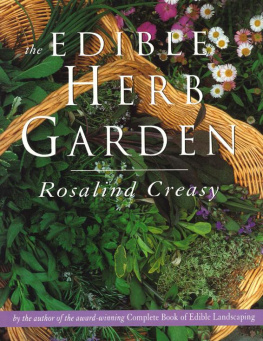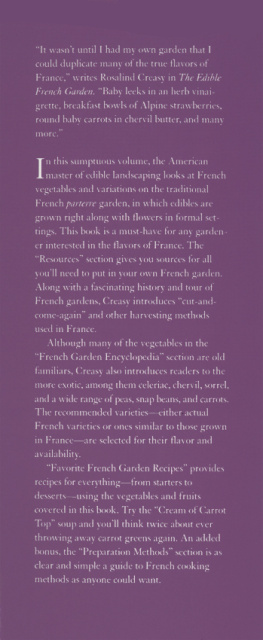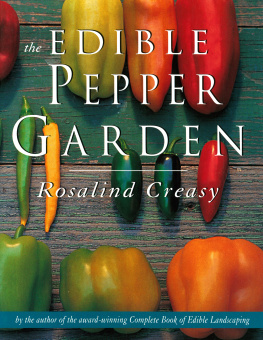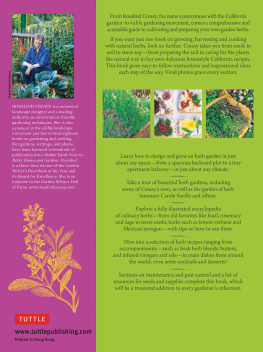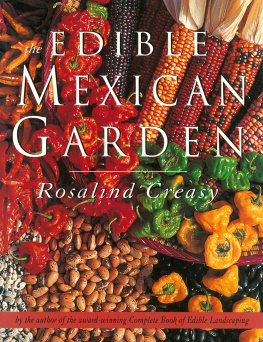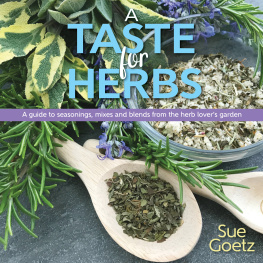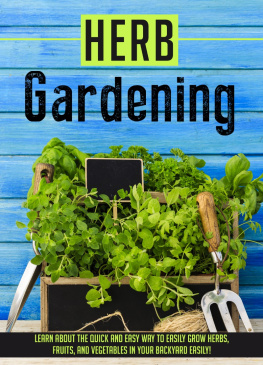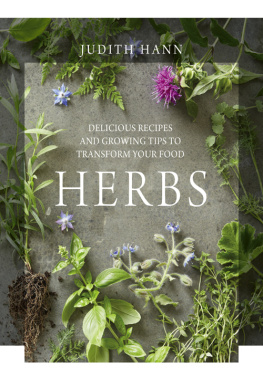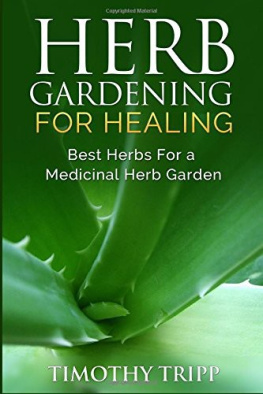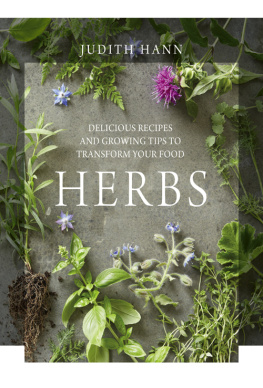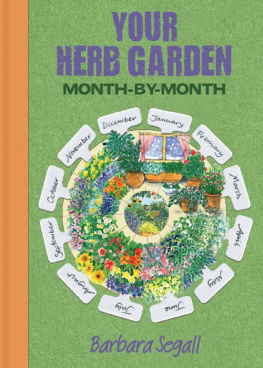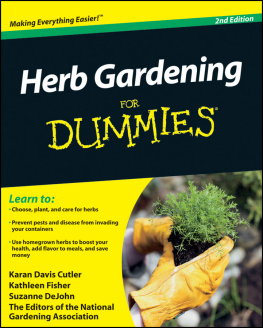

First published in 1999 by Periplus Editions (HK) Ltd.,
www.periplus.com
Photographs and text copyright 1999 Rosalind Creasy
Illustrations and watercolors by Marcie Hawthorne
All rights reserved. No part of this publication may be reproduced or utilized in any form or by any means, electronic or mechanical, including photocopying, recording, or by any information storage and retrieval system, without prior written permission from the publisher.
Library of Congress Cataloging-in-Publication Data
Creasy, Rosalind.
The Edible Herb Garden / by Rosalind Creasy.1st ed.
105 p.: ill. (some col.), col. map; 29 cm.
Includes bibliographical references (p.)
ISBN: 978-1-4629-0618-5 (ebook)
1. Cookery (Herbs). 2. Herbs. 3. Herb gardening. I. Title.
TX819.H4C7397 1999
641.6'57-dc21
98-34729
CIP
Distributed by:
|
NORTH AMERICA,
LATIN AMERICA & EUROPE
Tuttle Publishing
364 Innovation Drive
North Clarendon, VT 05759-9436 U.S.A.
Tel: 1 (802) 773-8930; Fax: 1 (802) 773-6993
info@tuttlepublishing.com
www.tuttlepublishing.com
| ASIA-PACIFIC
Berkeley Books Pte. Ltd.
61 Tai Seng Avenue, #02-12
Singapore 534167
Tel: (65) 6280-1330; Fax: (65) 6280-6290
inquiries@periplus.com.sg
www.periplus.com
|
JAPAN
Tuttle Publishing
Yaekari Building, 3rd Floor
5-4-12 Osaki, Shinagawa-ku
Tokyo 141 0032
Tel: (81) 3 5437-0171; Fax: (81) 3 5437-0755
tuttle-sales@gol.com |
First edition
12 11 10 10 9 8 7 6
Design by Kathryn Sky-Peck
Printed in Singapore

contents






This harvest of fresh herbs ( left ) is every chef's dream. Included are many of the stars of the culinary herb garden; ( clockwise from the top ) chives, French thyme, purple sage, sage flowers, silver lemon thyme, sage buds, rosemary, and French tarragon. In the middle are sprigs of Italian flat-leaf parsley and the flowers of German chamomile.
culinary herb gardens
W hat a luxury it is to have a garden full of herbs! Even this country's best chefs usually can't match the meals created from such a garden. Imagine having enough lemon thyme or fennel to be able to use the prunings for smoking pheasant or salmon. Think of creating a salad, as if from the heart of France, with fresh tarragon and chervil, or making a Thai salad with real Thai basil. Fresh herbs are the signature of a chef and often a specific cuisine, yet very few markets in this country offer more than a meager selection.
When I think back on my cooking of years ago, it feels as though I was working in black and white and monaural. The form was there and it was enjoyable, but the depth and richness were missing. Now that I regularly use fresh herbs, I'm cooking in full color and stereo. The zip of fresh mint or the many flavors of thyme give the dishes more dimension. Twenty years ago I started on my herb adventure by adding fresh chives to potato soup and fresh basil to spaghetti sauce. What a difference! I went on to use fresh dill on fish, pesto on pasta, and herb vinegars on salads. Now, after years of exposure to the full range of herbs, and thanks to many people's guidance, I use many more in my cooking, and almost all of them are fresh.
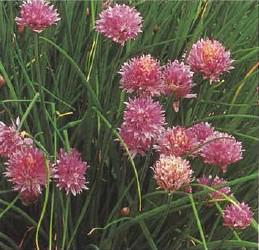
Herbs are the easiest to grow of all the edible plants and are great for beginning gardeners. Another incentive is that cooking with herbs can be a very healthful way to add excitement to meals. At a time when the safety of the salt and fats in our diet is being seriously questioned, it's a relief to explore enjoyable substitutes. I get so tired of being deprived in the effort to be "good." Using herbs deepens the pleasure as well as the healthfulness of food.
As I mentioned, my education in herb cookery started slowly. I was always an avid gardener, so years ago I put in a basil plant or two and some dill and chives, and that's still a good way to start. My serious interest in herbs took hold when I visited the herb garden at Caprilands in Coventry, Connecticut. This extensive garden, fueled by the enthusiasm of the late Adelma Simmons, actually contains many different kinds of herb gardens: one that attracts butterflies, an all-gray one, a garden full of scented geraniums, and another with herbs for drying. At Caprilands, my sister and I enjoyed a meal in which herbs were used in each course, and Adelma came around while we ate to talk about which ones we were enjoying. That trip to Caprilands opened my eyes to the vast world of herbs and their many possibilities.
Since then I have visited many public herb gardens, and I highly recommend them to other interested gardeners and cooks. Visiting these gardens is a great way to learn to identify the appearance, smell, and flavor of individual herbs. This country has hundreds of beautiful public herb gardens. Try a visit to our nation's herb garden in Washington, D.C., at the United States National Arboretum, or to the Cloisters, with its wonderful medieval garden, in New York City. Or sample herbs at the magnificent formal herb gardens at the Missouri and Chicago botanical gardens and the historical gardens at Old Sturbridge Village and Monticello. All grow a wonderful range of herbs and usually provide a guide to help you identify them.
Once I had a working knowledge of most of the herbs, I found I needed the help of creative cooks to explore herbs in the kitchen. For every one way I thought of to use an herb, someone like herb maven Carole Saville or Rose Marie Nichols McGee (who was raised in the shadow of Nichols Garden Nursery, a well-known herb supplier) had created ten. And in the hands of master chefs such as the late Tom McCombie of Chez T.J.'s in Mountain View, California, and Ron Zimmerman of the Herbfarm outside Seattle, Washington, dishes came alive with herbs.

A small collection of herb containers adorns my rose patio. The pineapple mint, sage, and lemon balm shown here grow well in all but the hottest humid climates.

There are dozens of varieties of thyme and I chose six different ones to set off my bird bath. In the perimeter beds I planted chives, scented geraniums, golden sage, and a selection of salad greens. To unify this little garden I included the showy, but decidedly not edible, tall graceful foxgloves and blue star creeper (Laurentia fluviatilis) in between the boards.
Next page
